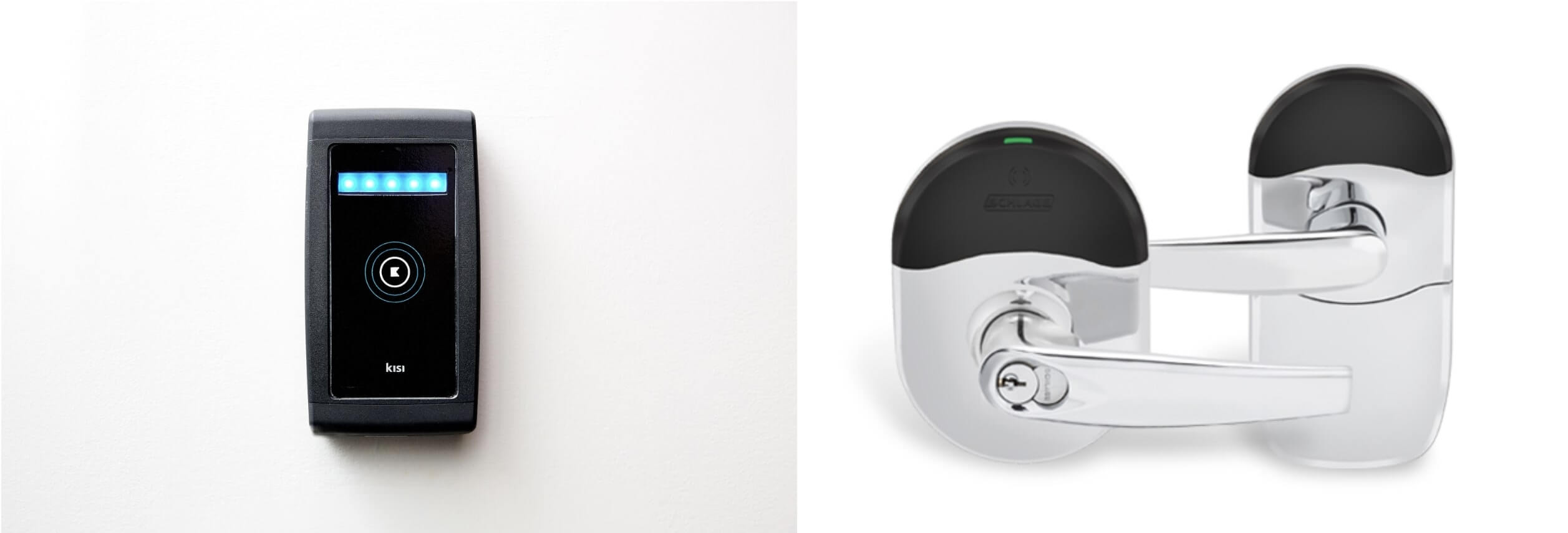Kisi’s market-leading access control solution enables unlock methods, including mobile devices, keycards, fobs, and third-party NFC and RFID credentials. Kisi's access control system incorporates Bluetooth Low Energy (BLE) technology to enable secure and convenient door access using smartphones or other Bluetooth-enabled devices. Learn more about Kisi’s different access methods and the benefits of Kisi access control.
What is Bluetooth technology? #
Bluetooth is a short-range wireless technology, which was first introduced by Ericsson Company in 1994 after its initiation in 1989. This technology operates in the ISM band, which is reserved for industrial, scientific, and medical applications. This is a free band and does not require lengthy licensing procedures and fees. It operates in two frequency ranges – 2400 to 2483.5 MHz and 2402 to 2480 MHz – via the frequency hopping spread spectrum radio interface technology.
The Bluetooth transmission frequency band is divided into 79 Bluetooth channels to transmit the data packet. The latest version of this communication technology, known as Bluetooth Low Energy or BLE, accommodates 50 active specification development projects at any given period, which could include adding minor features to adding significant functionalities of the existing Bluetooth technology.
Bluetooth Low Energy or BLE is developed by the Bluetooth Special Interest Group BSIG for high energy efficiency and performance. This technology is commonly marketed as Bluetooth Smart technology in the marketplace. The devices enabled with the BLE technology can operate for many months, even years, on a single-button cell/battery.
BLE technology is very suitable for the Internet of Things (IoT). BLE technology can operate with a maximum speed of 50 Mbits/s up to an effective distance of 800ft (240 meters).
Bluetooth technology versions #
Bluetooth technology has evolved through multiple versions since its inception. There are five major versions with sub-versions released so far, as given below.
- Bluetooth 1 (with multiple sub-releases). This represented the first major innovation and invention of the technology, but it was plagued by compatibility issues and a comparatively slow data transfer limit of 1 Mbps.
- Bluetooth 2 (with multiple sub-releases). This addressed some compatibility issues and increased the data limit to 3 Mbps.
- Bluetooth 3. This was a major boost, introducing the HS protocol that increased the data transfer limit to 24 Mbps, and allowing Bluetooth to run over an alternate radio, like the one used by Wi-Fi devices. This allowed it to pervade the market significantly more.
- Bluetooth 4 (With multiple sub-releases). This, among other fixes, introduced the LE (low energy) technology. This innovation allowed Bluetooth to be deployed in all sorts of wearable and portable systems, as they would need to be charged much less often (or would require far fewer battery changes). It allowed Bluetooth to break into the physical security market, as it could now be installed in all sorts of sensors and readers. This was the beginning of Bluetooth security systems.
- Bluetooth 5 is the latest version of Bluetooth. Bluetooth 5 features enhancements that improve the efficiency of how data is processed and strengthen connectivity in general, particularly in the IoT framework. It is optimized for IoT devices, by increasing range, speed, and broadcast capacity and enables Bluetooth to be deployed in all physical security systems.
What is Bluetooth access control? #
Like other short-range wireless access control technologies, Bluetooth can also be efficiently used as an effective access control technology. The Bluetooth security systems suite has been increasing at an ever greater pace in recent years, with the advent of smart homes and modern access control. The main applications of Bluetooth access control include home automation and access security systems.
There are large numbers of software applications available in the market that can be configured – commonly known as profiling – on Bluetooth-enabled mobile phones to establish short-range communication with Bluetooth-enabled proximity sensing devices. Other than those software applications, this technology can be implemented in an autonomous Bluetooth access control system too.
To enable an access control system to use smartphones, you will need a proximity reader enabled with Bluetooth signals to create a Bluetooth access control reader. A software application is installed on the smartphone, and the application is then profiled for access security use. When the smartphone is neared to the Bluetooth access control reader, the application communicates with the reader and, thus, exchanges the security key to authenticate and open the door lock.
Similarly, in an automated and networked house or office, your phone communicates with the centralized access controller, which controls the door locks in a networked environment. The security key is authenticated and the authorized door is opened through the signals from the main access controller.
Bluetooth access control readers offer several advantages. They provide a convenient and contactless access solution, allowing users to unlock doors or gain entry using their mobile devices without the need for physical keys or access cards. Bluetooth technology also enables real-time communication between the reader and the user's device, facilitating quick and seamless access.

The introduction of iBeacon protocol is another important milestone in using Bluetooth technology in more access control and security-related applications. It can be extensively used in the applications pertaining to location finding, which subsequently will trigger a major potential of marketing services. iBeacon has been implemented in multiple BLE-enabled devices that can easily communicate with the mobile applications in their respective ranges over Bluetooth technology. The power consumption of the iBeacon transmitter is very low and can operate for many months continuously on a small battery.
Bluetooth and smart locks #
Amongst the backdrop of changing lifestyle habits to doing everything on mobile, there is now a general push within the access control market to go from cards to mobile too. With unlocking doors from mobile becoming an ability people expect to have, it is poised to become the main method of unlocking doors in the next few years.
The latest example is a new generation of Bluetooth Low Energy (BLE)-enabled smart locks that are able to interact directly with the phone to unlock doors. Allegion has a range of such locks and for those looking to utilize the BLE function in their own Apps, they will be able to integrate the functions provided by Allegion.

For those who would like to utilize BLE to unlock doors without building an app from scratch, Kisi is integrated with Allegion to enable just that. Users can install Allegion door locks and unlock their doors through the Kisi app on their mobile.
The best use-cases for BLE locks are organizations looking for an access control security solution since these locks will be able to provide real-time communication and feedback. Among other benefits, this also means being able to grant or relinquish access immediately, and review real-time activity logs. Organizations with high traffic inflow and outflow will find these features most useful in streamlining their daily operations and strengthening their security.
As users will be required to swipe in-app to unlock, this also presents opportunities for any facility or workspace management apps looking to drive usage and engagement of their apps. By requiring users to unlock doors through their app, the app will now become a daily necessity rather than a possibility.
Conclusion #
Access control through Bluetooth technology uses mobile devices in association with third-party controllers and readers; this reduces the hardware cost for this application. Only software profiling is sufficient to use your mobile devices in different access control systems. With the advent of BLE technology in the market, this field has a bright future in this industry. To learn more about Kisi, take a look at our product overview or get in touch with our team.

